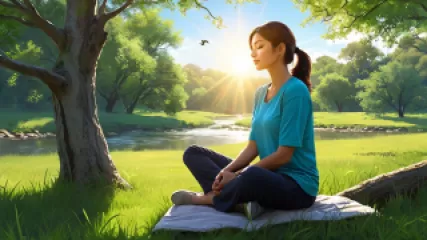10 Best Calming Techniques for Mindfulness and Anxiety Relief
Anxiety can be a debilitating experience that impacts various aspects of life. With the increasing pace of modern living, finding effective ways to manage anxiety has become more crucial than ever. Mindfulness, an ancient practice with contemporary relevance, offers numerous calming techniques that can help alleviate anxiety and promote mental well-being.
This article delves into the top 10 calming techniques for mindfulness and anxiety relief. These methods have been widely endorsed by mental health experts and practitioners for their efficacy in providing immediate and long-term anxiety relief. Whether you are new to mindfulness or looking to deepen your practice, this comprehensive guide will provide valuable insights and practical tips to help you navigate the turbulent waters of anxiety.
The Power of Deep Breathing
Deep breathing is one of the most accessible and effective ways to calm the mind and reduce anxiety. The practice involves taking slow, deep breaths that engage the diaphragm rather than shallow breaths that fill the chest. This technique helps activate the body's relaxation response and can be practiced anywhere, anytime.
How to Practice Deep Breathing
- Find a comfortable and quiet place to sit or lie down.
- Place one hand on your chest and the other on your abdomen.
- Inhale deeply through your nose, allowing your abdomen to rise while keeping your chest relatively still.
- Exhale slowly through your mouth, feeling your abdomen fall.
- Repeat this process for several minutes, focusing on the sensation of your breath.
Incorporating deep breathing into your daily routine can significantly reduce stress and enhance your overall sense of well-being. It is a cornerstone of many mindfulness practices and an invaluable tool for managing anxiety.
“Breath is the bridge which connects life to consciousness, which unites your body to your thoughts.” – Thich Nhat Hanh
Progressive Muscle Relaxation
Progressive Muscle Relaxation (PMR) is a technique that involves tensing and then relaxing different muscle groups in the body. This method helps increase awareness of physical sensations and promotes a state of deep relaxation, making it an excellent tool for anxiety relief.
Steps to Practice Progressive Muscle Relaxation
- Find a quiet and comfortable place to sit or lie down.
- Starting from your feet, tense the muscles in your toes by curling them tightly. Hold for a few seconds, then release.
- Move up to your calves, thighs, abdomen, chest, arms, hands, neck, and finally, your face, repeating the tensing and relaxing process.
- Focus on the contrast between the tension and relaxation in each muscle group.
- Spend a few moments enjoying the overall sensation of relaxation.
Practicing PMR regularly can help you become more attuned to your body's stress signals and provide a powerful way to alleviate anxiety on both a physical and mental level.
Guided Imagery for Anxiety Relief
Guided imagery involves using mental images to evoke a state of relaxation and tranquility. This technique can transport you to a peaceful place or situation, thereby reducing anxiety and promoting a sense of calm. Guided imagery can be practiced with the help of recordings or by creating your own mental scenarios.
How to Use Guided Imagery
- Sit or lie down in a comfortable position in a quiet space.
- Close your eyes and take a few deep breaths to center yourself.
- Imagine a peaceful scene, such as a beach, forest, or mountain meadow.
- Engage all your senses: visualize the colors, hear the sounds, feel the textures, and even smell the scents of your imagined environment.
- Spend several minutes immersing yourself in this calming scene.
Regular practice of guided imagery can help you develop a mental escape route from anxiety, providing an effective way to manage stress and enhance your overall mental health.
Mindful Meditation for Stress Reduction
Mindful meditation is a practice that involves focusing your attention on the present moment without judgment. This technique helps cultivate awareness and acceptance of your thoughts and feelings, making it a powerful tool for reducing anxiety and improving emotional regulation.
Steps to Practice Mindful Meditation
- Find a quiet and comfortable place to sit.
- Set a timer for a duration that suits you, starting with 5-10 minutes and gradually increasing as you become more comfortable.
- Close your eyes and take a few deep breaths to settle in.
- Focus your attention on your breath, noticing the sensation of the air entering and leaving your nostrils.
- If your mind wanders, gently bring your focus back to your breath without judgment.
With regular practice, mindful meditation can help you develop a greater sense of awareness and control over your thoughts, making it easier to navigate the challenges of anxiety.
Yoga: A Holistic Approach to Calm
Yoga is a mind-body practice that combines physical postures, breathing exercises, and meditation. It has been shown to reduce symptoms of anxiety and improve overall mental health. The practice of yoga encourages mindfulness and self-awareness, making it an effective tool for anxiety relief.
Basic Yoga Poses for Anxiety
- Child's Pose (Balasana): This resting pose helps calm the mind and relieve tension in the body.
- Cat-Cow Pose (Marjaryasana-Bitilasana): This gentle flow between two poses helps increase flexibility and reduce stress.
- Legs Up the Wall Pose (Viparita Karani): This restorative pose promotes relaxation and improves circulation.
- Corpse Pose (Savasana): This final relaxation pose allows the body and mind to rest and rejuvenate.
Incorporating yoga into your routine can provide a holistic approach to managing anxiety, enhancing both physical and mental well-being.
Aromatherapy for Emotional Balance
Aromatherapy involves the use of essential oils to promote physical and emotional well-being. Certain scents have been found to have calming effects on the mind and body, making aromatherapy a useful tool for reducing anxiety.
Popular Essential Oils for Anxiety Relief
- Lavender: Known for its calming and soothing properties.
- Bergamot: Helps elevate mood and reduce stress.
- Chamomile: Promotes relaxation and eases tension.
- Ylang-Ylang: Balances emotions and reduces anxiety.
To use aromatherapy, you can diffuse essential oils in your home, add a few drops to a warm bath, or apply diluted oils to your skin. Experimenting with different scents can help you find the ones that work best for your needs.
Journaling: Writing Away Your Worries
Journaling is a therapeutic practice that involves writing down your thoughts and feelings. This technique can help you process your emotions, gain insights into your anxiety triggers, and develop coping strategies.
Tips for Effective Journaling
- Set aside a specific time each day for journaling.
- Write freely without worrying about grammar or punctuation.
- Use prompts if you're unsure where to start, such as "What am I feeling right now?" or "What triggered my anxiety today?"
- Reflect on your entries to identify patterns and potential solutions.
Journaling can provide a safe space to explore your thoughts and feelings, helping you gain a deeper understanding of your anxiety and how to manage it effectively.
Engaging in Creative Activities
Creative activities such as painting, drawing, music, and crafting can be powerful tools for alleviating anxiety. These activities provide an outlet for self-expression and can help distract the mind from anxious thoughts.
Benefits of Creative Activities
- Encourages mindfulness and presence in the moment.
- Provides a sense of accomplishment and satisfaction.
- Allows for emotional expression and catharsis.
- Can be a fun and enjoyable way to relax.
Incorporating creative activities into your routine can provide a healthy and enjoyable way to manage anxiety and enhance your overall well-being.
Physical Exercise: Moving Towards Calm
Physical exercise is a well-documented method for reducing anxiety and improving mental health. Exercise releases endorphins, which are natural mood lifters, and helps reduce levels of the stress hormone cortisol.
Effective Exercises for Anxiety Relief
- Walking: A simple and accessible form of exercise that can be done almost anywhere.
- Running: Provides a cardiovascular workout and can be a great way to release pent-up energy.
- Swimming: Combines physical exertion with the calming effects of water.
- Dancing: A fun and social way to get moving and lift your spirits.
Incorporating regular physical activity into your routine can significantly reduce anxiety and improve your overall sense of well-being.
Seeking Support: Virtual Therapy and Online Resources
Sometimes, managing anxiety requires professional support. Virtual therapy and online mental health resources offer convenient and accessible options for those seeking help.
Benefits of Virtual Therapy
- Accessibility: Available from the comfort of your home.
- Flexibility: Sessions can be scheduled at times that suit you.
- Variety of Options: Includes individual therapy, group sessions, and specialized programs.
Online mental health support can provide valuable guidance and tools for managing anxiety. Whether through virtual therapy for anxiety, mindfulness resources, or an anxiety self-help program, these platforms offer a wealth of information and support.
Summarizing the Journey Towards Calm
Managing anxiety is a multifaceted journey that requires a combination of techniques and strategies. The ten calming techniques discussed in this article provide a range of options for finding relief and enhancing overall well-being. By incorporating practices such as deep breathing, progressive muscle relaxation, guided imagery, mindful meditation, yoga, aromatherapy, journaling, creative activities, physical exercise, and seeking professional support, you can create a personalized approach to managing anxiety.
Remember, the goal is not to eliminate anxiety entirely but to develop effective ways to manage it. Each individual's experience with anxiety is unique, so it's important to explore different techniques and find what works best for you. With consistent practice and a commitment to self-care, you can navigate the challenges of anxiety and cultivate a greater sense of peace and mindfulness in your life.
Blake Johnson is a mental health advocate and mindfulness practitioner with over a decade of experience in helping individuals manage anxiety and stress. He believes in the power of holistic approaches and is passionate about sharing practical techniques for mental well-being.






